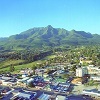Video
GEORGE NEWS AND VIDEO - An old milkwood tree that provided shade for generations at Leentjiesklip has died, presumably because of infestation by the Longicorn beetle. According to local resident Mike Leggatt this could have been prevented.
Leggatt says when officials of George Municipality's parks department visited the tree a few years ago regarding the infestation by the Longicorn, he offered to treat all the infected trees in the area for free, if the municipality would supply the pesticide (Koinor). He was also willing to help identify trees on municipal land in Wilderness that were infected, as well as present a course at no cost for officials if they wanted to carry out the treatment themselves. His offer was never taken up. He suspects another tree at Wilderness Station is also under stress from this bug.
He and a friend had successfully treated the old Post Office Tree in Mossel Bay against this beetle.
Leggatt says he has also offered to teach municipal and Eskom workers | contractors how to prune trees around overhead power and telephone lines. Incorrect pruning methods do not allow the trees to heal properly and can cause rotting, disease and eventual death. A tree should also look as natural as possible after pruning. "This is something that those who work on trees on municipal or government property in Pretoria seem to have achieved. It would probably take an hour to teach that knowledge to those responsible in George and given the destruction caused by the Shot Hole Borer and the Longicorn beetle, one would think that there would be some interest in how to ensure that the remaining trees are properly looked after."
Watch a video below:
Recently appointed superintendent at the parks department, Priscilla Burgoyne*, is unaware of someone volunteering information about the Longicorn in the time she has been at the municipality. "I welcome any input ... someone that has lived here for so long has unique knowledge that is always welcome. There are cases involving keurboom in the Garden Route Botanical Garden that appear to have been killed by a similar worm, but the former Gardens Trust chairman Colin Ralston continues to monitor the situation," she says. "He had a difficult time tracing the worms to maturity and having them identified, but confirmed the family Cerambycidae. There is currently no confirmed information about milkwood trees being infested with this species, which was confirmed by two of the town's tree specialists, Braam du Preez and Dr Jaap Steenkamp. I will, however, monitor the milkwoods in the area for possible infestation."
Prof Christo Fabricius was quoted in a George Herald article two years ago as saying that milkwood forests that historically stood along our coast (as one can see in the small railway reserve north of Sands Road and on two properties in Sands Road closer to Leentjiesklip) are utterly important parts of infrastructure. A milkwood forest is a complete ecosystem with lots of other plant and bird species that populate it. This rich ecosystem not only protects plant and animal life, but also property and man-made infrastructure against the impact of the sea.
 The Longicorn beetle in the larva phase.
The Longicorn beetle in the larva phase.
 Tree pruning not done correctly not only mars the aesthetic appearance, but could also lead to rotting, and eventually the death of the tree.
Tree pruning not done correctly not only mars the aesthetic appearance, but could also lead to rotting, and eventually the death of the tree.
* Burgoyne holds a master's degree in Botany from Tswane University of Technology and has worked at the South African National Biodiversity Institute (Sanbi) for 21 years before settling in George in 2015. She was curator at the Garden Route Botanical Garden's herbarium until her appointment at the municipality last year.
'We bring you the latest George, Garden Route news'
















